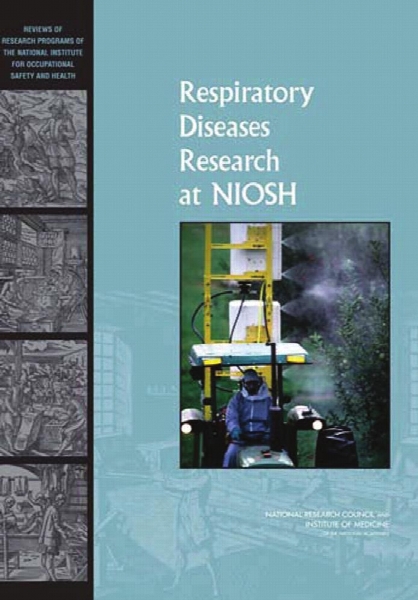Respiratory diseases research at NIOSH : reviews of research programs of the National Institute for Occupational Safety and Health
- نوع فایل : کتاب
- زبان : انگلیسی
- مؤلف : National Research Council (U.S.). Committee to Review the NIOSH Respiratory Diseases Research Program.; National Research Council (U.S.). Board on Env
- ناشر : Washington, D.C. : National Academies Press
- چاپ و سال / کشور: 2008
- شابک / ISBN : 9780309118736
Description
Contents SUMMARY 1 1 INTRODUCTION 15 Overview of the Respiratory Diseases Research Program, 18 Study Charge and Evaluation Committee, 27 Evaluation Approach, 28 Organization of the Report, 32 2 EVALUATION OF THE RESPIRATORY DISEASES RESEARCH PROGRAM 34 RDRP Goals, Subgoals, and Resources, 35 External Factors Affecting the RDRP, 35 Surveillance, Health Hazard Evaluation and Technical Assistance Program, and Other Input Activities, 39 Introduction to Relevance and Impacts Assessment, 42 Strategic Goal 1: Prevent and Reduce Work-Related Airway Diseases, 43 Strategic Goal 2: Prevent and Reduce Interstitial Lung Diseases, 59 Strategic Goal 3: Prevent and Reduce Work-Related Infectious Respiratory Diseases, 81 Strategic Goal 4: Prevent and Reduce Work-Related Respiratory Malignancies, 97 xii C o n t e n t s Strategic Goal 5: Prevent Respiratory and Other Diseases Potentially Resulting from Occupational Exposures to Nanomaterials, 109 Overall Assessment of the RDRP Relevance and Impacts, 117 3 EMERGING RESEARCH AND RESEARCH ISSUES 120 Strategic Goal 1: Prevent and Reduce Work-Related Airways Diseases, 120 Strategic Goal 2: Prevent and Reduce Work-Related Interstitial Lung Diseases, 122 Strategic Goal 3: Prevent and Reduce Work-Related Infectious Respiratory Diseases, 125 Strategic Goal 4: Prevent and Reduce Work-Related Respiratory Malignancies, 127 Strategic Goal 5: Prevent Respiratory and Other Diseases Potentially Resulting from Occupational Exposures to Nanomaterials, 128 Cross-Cutting Issues: Continuing and Emerging Issues Cutting Across Multiple Program Goals, 129 4 RECOMMENDATIONS 132 Strategic Goal 1: Prevent and Reduce Work-Related Airway Diseases, 132 Strategic Goal 2: Prevent and Reduce Work-Related Interstitial Lung Diseases, 139 Strategic Goal 3: Prevent and Reduce Work-Related Infectious Respiratory Diseases, 141 Strategic Goal 4: Prevent and Reduce Work-Related Respiratory Malignancies, 143 Strategic Goal 5: Prevent Respiratory and Other Diseases Potentially Resulting from Occupational Exposures to Nanomaterials, 144 Cross-Cutting Issues, 145 Broader Programmatic Goals, 149 REFERENCES 150 APPENDIXES A Framework for the Review of Research Programs of the National Institute for Occupational Safety and Health 173 B Stakeholder Responses: Online Survey 217 C Bibliographic Information for the Committee to Review the NIOSH Respiratory Diseases Research Program 223 D Biographic Information on the Committee to Review the NIOSH Respiratory Diseases Research Program 226
Respiratory diseases caused by exposures to dangerous materials in the workplace have tremendous implications for worker health and, by extension, the national economy. The National Institute for Occupational Safety and Health (NIOSH) estimates that deaths from work-related respiratory diseases and cancers account for about 70% of all occupational disease deaths. NIOSH conducts research in order to detect and reduce work-related hazardous exposures, injuries, and diseases; its Respiratory Disease Research Program (RDRP) focuses on respiratory diseases. This National Research Council book reviews the RDRP to evaluate the 1. relevance of its work to improvements in occupational safety and health and 2. the impact of research in reducing workplace respiratory illnesses. The assessment reveals that the program has made essential contributions to preventing occupational respiratory disease. The National Research Council has rated the Program a 5 out of 5 for relevance, and a 4 out of 5 for impact. To further increase its effectiveness, the Respiratory Disease Research Program should continue and expand its current efforts, provide resources for occupational disease surveillance, and include exposure assessment scientists in its activities.


